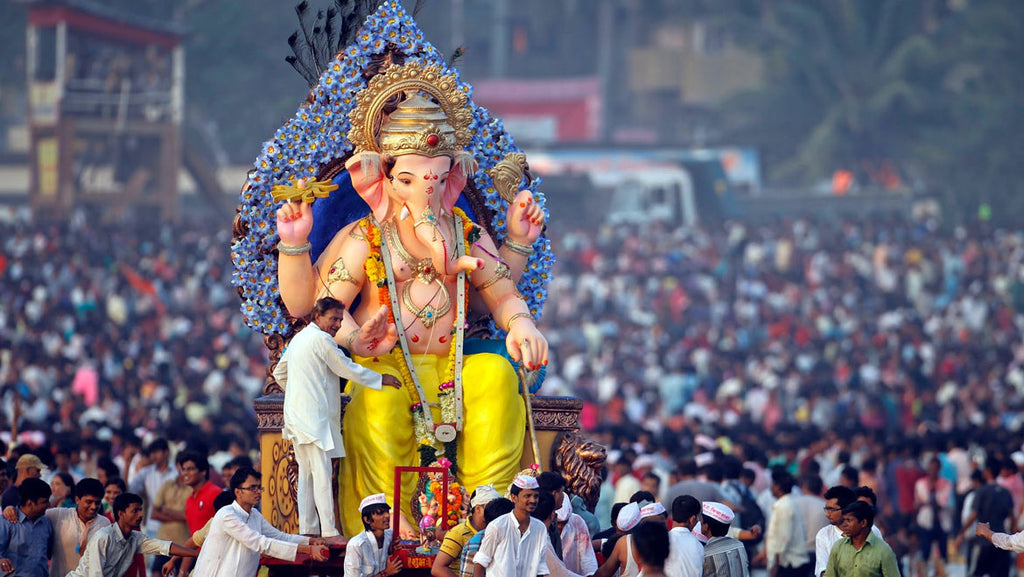Indian Festivals: Ganesh Chaturthi - The Birthday of The Elephant God
By Conchita de Souza

Featured Image: Mumbai Attractions
In India, the festival season is celebrated with a fervour I’ve never before experienced. The streets are flooded by crowds of bodies, around every corner rhythmic music blasts from over-sized speakers and the colours, oh my the colours, are a feast for the eyes. No matter where you are in India, it is impossible to be left untouched by the excitement and joy brought on by the festivals.
The festive season begins with Rakhi (celebrating sibling love) in August and ends with Diwali, usually in October/November depending on the Hindu Calendar. During this period, the heat of summer has been tempered by the monsoon rains and the slow (and in some places, mild) onset of winter begins. Families and friends prepare for festive season like how we would in Australia - shopping, cleaning, decorating, and most importantly, cooking! Each festival marks a particular event or season; the start of a new year (Diwali), thanksgiving for the harvest (Lohri), commemorating the homecoming of a legendary Emperor (Onam) are just a few examples.
Soon after winter is over and just before the long, harsh and sultry summers begin, another festival called Holi begins. Each region has its own festivals during this time. In this series, we cover four of the main Hindu festivals - Ganesh Chaturthi, Dussehra, Diwali and Holi and leave out minority festivals (such as those celebrated by the Jain, Parsi, Muslim and Christian communities) as well as state and regional festivals. The festive season is described through my eyes and mostly narrated through all that my five senses experienced.
Ganesh Chaturthi
This is a 10 day-long festival celebrating the birth of Lord Ganesha - the elephant God. Lord Ganesha is the God of Wisdom, Success and Prosperity and therefore he is honoured at the commencement of all things big and small, so that they may turn out well. Whether it be the beginning of a road trip or the beginning of a child’s first day at school, his name will always be invoked.
I was fortunate enough to experience this festival in two cities of India - Ahmedabad and Hyderabad. During the 10 day period, pandals (makeshift tents) are set up to house the elaborately painted and intricately adorned Ganesha idols so communities can come and worship. The most magical (and somewhat disruptive) part of this festival is the immersion of the idol into water - usually into the main rivers, lakes or oceans nearby. The heavy traffic on the roads comes to a screeching halt as truckloads (literally, for they are all ferried around in pimped-up trucks) of devotees flock in style to the water to immerse their Ganesha murti (statue). The murtis range in size; some are compact enough to be held in the palm of the hands and others are built to towering heights of 30 - 40 feet.
And when I say in style, they sure know how to bring it; processions of people dancing and throwing powders of colour as they cheerfully dance behind their Ganesha murti, who is usually on the back of an open lorry which also has oversized speakers blasting party music. It’s a spectacle indeed! In Hyderabad, there is a large man made lake called Hussain Sagar. The bridge passing over it is a popular point for immersing the murtis. Every year during the festival, cranes are stationed along the sidewalk of the bridge so that devotees can immerse their Ganeshas by placing them on a platform which is lowered into the lake by a crane. I was absolutely flabbergasted to see the meticulous planning by the local council of Hyderabad to ensure that everyone had the chance to fully participate in the rituals, no matter the limitations (Hyderabad is a landlocked city with no river bodies flowing through it).
Specialities
The most exciting part of the festive season is that each festivity is accompanied by an array of edible delights. The menu differs depending on where in India you happen to be celebrating. I have described below, some of the most popular sweet dishes prepared during Ganesh Chaturthi.
Modak
With Ganesh Chaturthi just around the corner, mithai shops (shops that sell sweets) across India will be pumping out these sweet dumplings in the thousands. Modaks are traditionally made of rice flour and stuffed with jaggery* and slivers of fresh coconut, but these days you can even find chocolate-flavoured Modaks.
Here is the story behind why modaks are believed to be Lord Ganesh’s favourite sweet. His mother Goddess Parvati received a special modak from the demi-gods and she intended to split it between her two sons – Lord Ganesh and Lord Karthik. Neither were willing to share and so Parvati set them a challenge – whomever of the two would be first encircle the world three times over would get the entire sweet to himself. Karthik was quick to mount his peacock and set off. Ganesh instead circled his parents three times, his devotion and sincerity winning the hearts of his parents, who gave him the much sought after sweet.

Image: www.newwomanindia.com
Shrikhand
Shrikhand is a popular prasad** item during many festivals in the states of Gujarat and Maharashtra. It is made from hung curd (plain yoghurt which has been drained of as much moisture), sweetened with sugar, spiced with saffron-infused milk and garnished with nuts and dried fruits. You can purchase Shrikhand from the sweet stores and it is available in flavours like mango and, cardamom. Shrikhand has a slight sourness to it and is very dense and creamy, which means you can enjoy it in small quantities. Sometimes it is served alongside hot puris (deep-fried flatbread), which is heavenly because it melts just a little when scooped up with the bread.

Image: sailusfood.com
Puran Poli
This sweet hails from the western state of Maharashtra and is a flatbread made from plain flour and stuffed with sweet lentils and jaggery.

Image: yummyfoodrecipes.in
Motichoor Laddoo
Laddoos are a type of Indian sweet which come in all kinds of flavours and varieties, but are always spherical in shape. Motichoor Laddoos are another favourite of Lord Ganesh’s (he sure has a sweet tooth!). In representations of him, he is seen carrying a bowl of laddoos in one of his four hands. These laddoos are made from a mixture of gram flour/chickpea flour, milk and sugar. Its texture is soft enough to melt in your mouth, but also just a little bit grainy.

Image: http://welcomenri.com
Have we missed out on any of your favourite Ganesh Chaturthi dishes? Comment below and let us know!
*Jaggery is unrefined sugar, usually made from the sap of palm trees or from boiled down sugar cane juice
**Prasad is usually a food offering made to God

0 comments